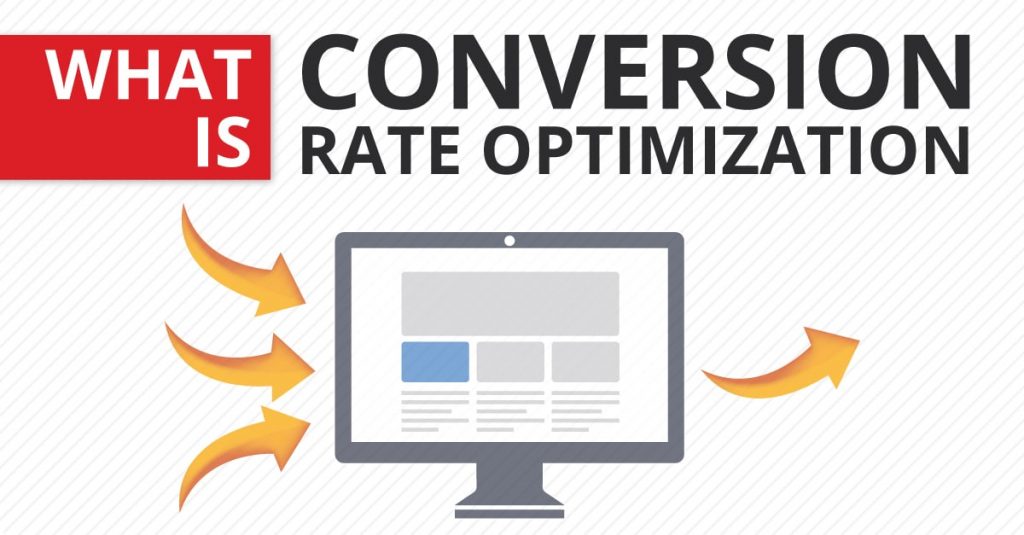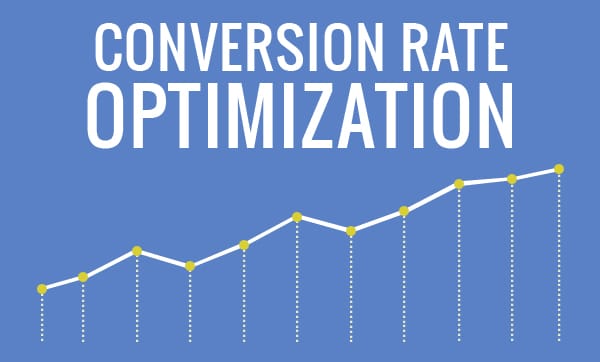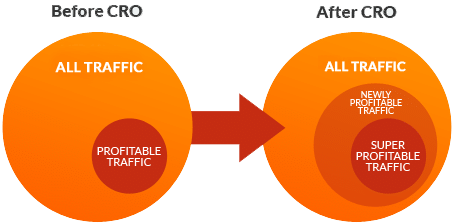Conversion Rate Optimization is very important for every kind of websites. Below is the definition of Conversion Rate Optimization and Reasons Conversion Rate Optimization is Important to your Business.
What is Conversion Rate Optimization?
Conversion Rate Optimization (CRO) is the process of improving the ratio of conversions to traffic on a website. For example if your website is receiving 1,000 visitors per month and 10 of them buy your product, you have a conversion rate of 1%.
Using CRO, one would look to steadily improve the conversion rate, without specifically looking to develop inbound traffic.
To extend this example, if after three months your site’s traffic had naturally grown to 1,100, but the Conversion Rate Optimization work had increased the conversion rate to 2%, then 22 people would be buying your products online each month. This would indicate that the CRO had been extremely effective.
Get 50% Discount to Master ALL Aspects of Digital Marketing That Can Earn You $2,500 - $5,000 a month (Even if you are a complete beginner!)
Our students that intentionally implement what they learn from our digital marketing course make back the entire course fee within a single month or more after completing our course because our course gives them many income generating options with unlimited earning potential with no age or location barrier. The best part is no technical skills are required.
An opportunity to change your lifestyle and make money working from anywhere in the world. The results our students get from our digital marketing course prove this could be applied to any market or country and that it is designed for any skill level and work background.
*By signing up, you agree to our privacy policy and terms of service.
CRO is an often neglected aspect of a digital marketing strategy. I regularly see and work with websites receiving respectable and growing amounts of traffic but still fail to convert that traffic efficiently.
The enticement in SEO for some is to draw a line in the sand immediately after delivering traffic to the site. This is evident when someone comes to me after having undergone a successful SEO campaign for some time, but they still aren’t generating the business required to sustain it.
Importance of Conversion Rate Optimization
Nothing is Perfect and Incremental Increases are Always Achievable
Your site could be the most attractive site on the internet from an aesthetic point of view. Your conversion rate could be sitting above the market average and your profit could be through the roof.
But what if you can make more money? Conversion optimisation is a process that should be continuous for the lifespan of your online business.
There are always opportunities to make improvements to your site, by better understanding your target market and the decision-making processes involved. Testing can squeeze out incremental increases that over time add up to a great step forward and ultimately more profit.
Competition and Cost of Paid Advertising are Increasing
Paid advertising is currently at the strongest it has ever been, and competition for clicks and paid real estate in search results is at an all-time premium. Spending more money to compete may seem like the best option, but it isn’t the right way to approach your business.
What if you could work with the traffic you already have to improve conversion rates? Conversion rate optimisation (CRO) allows you to concentrate on your current traffic, improve conversion rates, generate more ROI, and ultimately climb the paid search competition ladder.
Lower Acquisition Costs Aid to Maximise Profit, and Give you More Money to spend on Additional Acquisition
Increasing your conversion rate has the added effect of reducing your cost per acquisition (CPA). Doubling your conversion rate means you halve your CPA, meaning each new customer costs you half as much to acquire. It’s also important to note that profit is closely tied to your conversion rate.
If you are not paying more money to acquire additional conversions, all of that profit goes into increasing your bottom line. The knock-on effect of increased profit is that you now have more money to spend on acquiring new customers, and are in a stronger position to bring those much sought-after users.
Optimization Gives You Room To Concentrate on the Traffic that Matters
Many companies fall into the trap of looking at the whole site conversion rate at a top level and make heuristic decisions without much justification.
Segmentation is the key to conversion rate optimisation. Understanding which segments of traffic are converting or not converting is essential.
This in turn allows you to concentrate on the traffic that matters and not waste resources making changes that won’t have any real impact on your ROI.
It’s Kind Of Free
Conversion rate optimisation makes use of the current traffic you already drive to your site. Extra money isn’t spent across different channels trying to obtain more traffic. Apparently, there will be some cost involved, usually in the format of resources, but in essence, it can be seen as ‘free’.
CRO increases your ROI either by improving conversion rates or increasing the quality of conversions through your site.
This is a much better and cost-effective way of making more revenue over the tactic of throwing money at all channels and trying to acquire more visitors. That being said the extra revenue opens doors to acquiring more traffic, a cycle that can be exponential.
It can Mean Winner Take All
Based on the concept of the “slight edge” phenomenon (also known as “the winner takes all” or “the winner takes most”), all you need to be successful is to be slightly better than your competitors.
Therefore, if you optimize your site to deliver what users want in just a slightly better or faster way, even if it’s just a few seconds faster, they are going to go with you.
6 Conversion Rate Optimization Techniques
1. Identify your conversion goals
The first step in having an effective conversion rate optimization (CRO) is to identify your conversion goals. Start by determining what actions you want visitors to take on your website, such as making a purchase, signing up for a newsletter, or downloading a resource.
When you clearly define the goals, it provides a benchmark for measuring success and helps guide your optimization efforts. You can use analytics tools to track user behaviour and gather data on current conversion rates.
This information will enable you to pinpoint areas for improvement and develop targeted strategies to enhance user experience, ultimately driving higher conversions and maximizing your marketing ROI.
2. Analyze Your Current Sales Funnel
After setting a conversion goal for your campaign, you also need to analyse your current sales funnel to understand how potential customers interact with your business.
Begin by mapping out each stage of the funnel, from awareness to decision-making. We have various CRO tools you can use to track user behaviour at each stage to identify drop-off points where visitors abandon the process. This data can reveal insights into potential barriers, such as unclear messaging or complicated navigation.
When you pinpoint these challenges, you can implement targeted improvements, such as optimizing landing pages or enhancing calls to action. A thorough analysis of your sales funnel allows you to streamline the customer journey, ultimately increasing conversion rates and boosting revenue.
3. Focus on High-Traffic or Underperforming Pages
When you analyse your funnel, your main focus should be to identify high-traffic or underperforming pages in order to boost your conversion rates.
Start by identifying pages that attract a lot of visitors but aren’t converting well. These pages have the potential to deliver significant results with some targeted improvements. You need to analyze user behaviour and look at metrics like bounce rates and average time on the page to pinpoint issues.
You can make one or two adjustments to see maybe it will improve user experience and encourage more visitors to take action, ultimately maximizing the effectiveness of your website.
4. Create Hypotheses
Hypotheses are another important part of the conversion rate optimization process. You can use it to analyze your website data to identify areas for improvement. Based on your findings, you can formulate specific and testable hypotheses about how changes might impact user behaviour.
For example, you might hypothesize an effect that simplifies the checkout process to reduce cart abandonment rates. Ensure your hypotheses are clear and measurable, as this will guide your A/B testing efforts.
When you systematically test these hypotheses, you can gather valuable insights into what works best for your audience, allowing you to make informed decisions that enhance conversion rates effectively.
5. Test Your Hypotheses
Once you’ve formulated clear hypotheses based on data analysis, you need to implement A/B tests to compare the original version of a page with the modified one. Ensure that you isolate one variable at a time, such as changing a call to action or adjusting the layout.
You need to monitor your key performance indicators, like conversion rates and engagement metrics to evaluate the impact of these changes.
Also, collect and analyze the results to determine which version performs better. This systematic approach allows you to make data-driven decisions, optimizing your site for improved user experience and higher conversions.
6. Review and Iterate
After conducting tests and analyzing results, take your time to evaluate what worked and what didn’t. Look for patterns in user behaviour and feedback to identify further areas for enhancement.
Use these insights to refine your strategies and make informed adjustments to your website. Also, it is important to treat this process as ongoing, and regularly revisit your hypotheses and testing methods to adapt to changing user needs and market trends.
How Do I Calculate My Conversion Rate?
To calculate your conversion rate, divide the number of conversions (desired actions taken) by the total number of visitors to your website. Then multiply that result by 100 to get a percentage.
For example, if you had 1,000 visitors and 50 conversions, your conversion rate would be 50/1000 ×100=5%. This metric helps you understand how effectively your site turns visitors into customers.
What Are Some Common Strategies for Improving conversion rates?
Some strategies for improving conversion rates include simplifying the checkout process, optimizing call-to-action buttons, enhancing website speed, and using persuasive copywriting.
Additionally, incorporating trust signals like customer testimonials or security badges can reassure visitors. A/B testing different elements on your site such as headlines, images, and layouts can also provide insights into what resonates best with your audience.
Is Conversion Rate Optimization a One-Time Process?
No, Conversion Rate Optimization is not a one-time process; it is an ongoing effort. User behaviour and market trends change over time, so continuous testing and iteration are essential for maintaining and improving conversion rates.
When you regularly review the analytics data and user feedback, you can now implement these new strategies to ensure that your website remains effective in converting visitors into customers.
Finally
Conversion Rate Optimization (CRO) is important for turning your website visitors into customers. You can start by analyzing user behaviour, testing different strategies, and improving your site’s design and content to boost conversions and grow your business.
CRO also helps you get more value from the traffic you already have, making it a cost-effective way to increase revenue. If you want to learn how to implement effective strategies and make data-driven decisions that drive results, register for our digital marketing course to gain hands-on experience, expert insights, and practical tools that will empower you to optimize your website effectively.







